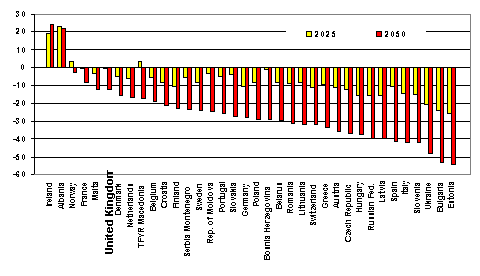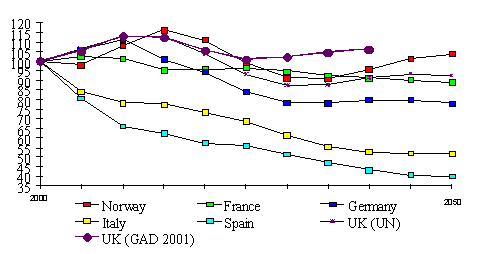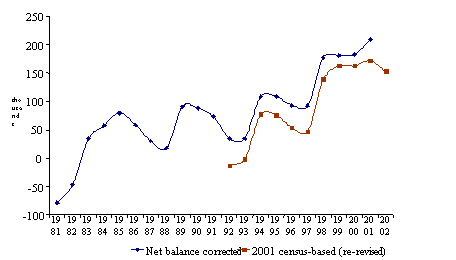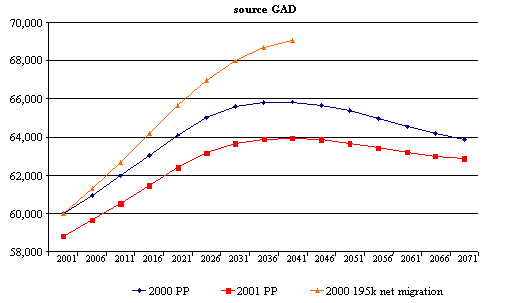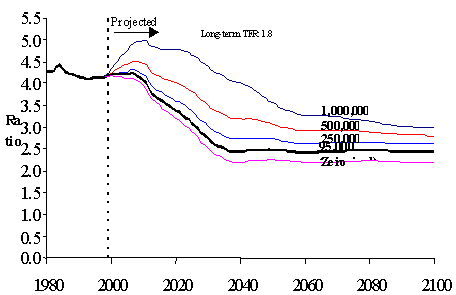International Longevity Centre – UK
and
The Faculty and Institute of Actuaries
You’re Welcome?
A debate on immigration and the effects of an ageing society
1st
December, London
Chair:
Professor Ceri Peach,
Professor of Social Geography, University of Oxford
Speakers:
Professor David Coleman, Professor
of Demography at the University of Oxford
Professor
Coleman has progressed from Lecturer to Professor of Demographics at Oxford
University and has worked for the government as well as being a consultant for
the Home Office, the United Nations and elsewhere. He has published over 90
papers and 8 books. He currently sits on the Advisory Council of Migration Watch
UK as Honorary Consultant and is known for his major contribution to the debate
on UK immigration policy. One of his current projects is the demographic
consequences of migration to the UK.
Dr. Heaven Crawley, Associate
Director of Migration and Equality, IPPR
Dr.
Crawley is a founder member of the Refugee Women's Legal Group and co-produced
the UK's Gender Guidelines for the Determination of Asylum Claims. She
previously worked at the Home Office's research directorate establishing a
programme of research on asylum and immigration issues in the UK and Europe and
is currently editor of the IPPR Asylum and Migration Working Paper Series. She
is the author of numerous publications on migration and asylum in the UK and
Europe, race, gender equality, and human rights and features regularly in the
print and broadcast media. She was recently noted as one of the Guardian’s top
50 women in the country to watch.
Table of contents
1.
Key Points
2.
Introduction
3.
UK future
demographic decline
3.1 The
Potential Support Ratio (PSR)
4.
Immigration
into the UK
4.1 UK
immigration policy
4.2 Current
UK labour migration programmes
4.3 Origin of
work permit holders
5.
Future effect
of immigration on UK demographics
6.
Immigration and
the UK PSR
7.
Alternative or
complementary strategies to immigration
7.1 Boosting
fertility rates
7.2 Increasing
existing workforce productivity
7.3 Extending
retirement age
8.
Conclusion
9.
Questions and
comments from the floor
10. Summing up
1. Key points:
- Many Western countries are enjoying the not undesirable trends of rising life expectancy and lower birth rates. However, public debate has long asked if, and how, increasing immigration could provide a solution to the economic and social challenges that these demographic challenges will bring.
- The Potential Support Ratio (PSR) is the ratio of people of nominal working age, ie. 15 to 64, to those of retirement age, ie. 65 or over. In 2002 this ratio was 4.2 for the UK. By 2050, this is expected to fall to 2.1, placing a greater burden on pensions and public services.
- Varying future immigration scenarios, ranging from an inflow of 500,000 migrants to zero net immigration per year, would only be able to change the UK PSR by around half a point either way into the foreseeable future.
- From a demographic viewpoint therefore, labour migration alone cannot maintain the support ratio. Countries with both high and low migration inflows must expect major structural demographic change.
- However, it is also clear the Potential Support Ratio is an overly simplistic tool in analysing the issues and determining policy, partly because it does not take account of workforce participation rates. It should include those under working age.
- Instead of seeking a ‘solution’ to population ageing purely in a demographic sense we should consider what policies could make the economic effects of an ageing society more manageable. These should include:
Increased fertility as has been achieved in other European countries
Workforce participation rates: Increasing workforce participation within the existing population would significantly readdress the ‘real’ support ratio
Extending working
life: Encouraging later retirement has the potential to raise the support
ratio significantly.
Continued managed labour migration: high skills gaps in the workforce and the evolution of the labour market mean a degree of immigration will continue to be advantageous to an ageing society
- A variety of policy goals exist which would help realise some the policies above:
Creating more flexible work conditions and providing better childcareon a Scandinavian model is likely to encourage women to have more children
Flexible work for older citizens and a more gradual transition from employment into retirement after 65 would help to extend working age. Financial disincentives for retiring later should be removed.
Social cohesion policies would help to ensure a higher rate of workforce participation amongst existing ethnic minority groups.
Providing more encouragement and incentives to parents would ease the burden of having children and promote larger and more socially cohesive families. Financial incentives appear to have had some success abroad in achieving this. The benefits of responsible parenthoodfor both men and women have been the subject of high profile campaigns in Scandinavian countries.
2. Introduction:
The history of the Western world since 1945 has largely been one of rapid economic expansion and great increases in living standards. In addition the unsustainably high birth rates of the 19th and early 20th Century have been left behind, creating a population that has not kept pace with economic demands for labour. Changes in the labour market, demands for skills and public expectations of working life have encouraged varying levels of immigration, whether the host society has achieved a public consensus in favour of its economic benefits or not.
In some countries, such as the US, economic demands for labour have won over the social objections that tend to accompany immigration; Hispanics, a relatively recent ethnic group to arrive in US, now total 13% of the population, and foreign-born labour 9%. In Europe the EU 15 average is 5%, although it varies a great deal between the industrialised countries of the North West and the less developed East and Mediterranean. Today, the ethnic minority population of the UK is around 8%, compared with 10% in France and slightly more in Germany. In others, such as Japan, political objections have won over economic demand, creating a much lower level of inward labour migration.
However, all western countries essentially face very similar demographic challenges in the next 40 years. Population ageing, already making an impact, and population decline are not so far around the corner. The UN has recently even begun to consider the possibility that the global population will begin to decline from 2070 or earlier. As populations age, and fewer younger people of working age support a burgeoning population of over 65s, all Western countries will no doubt be asking what the effect of an ageing population will be on their pensions, public services and economy, and how immigration may play a role in improving the situation.
3. UK future demographic decline
Relative percentage of population decline in selected countries 2000 to 2050, aged 15 to 64.
|
|
|
|
|
|
Every Western country faces major demographic change over the decades
to come. The twin effects of increased longevity and low birth rates, the
former certainly a sign of a mature society if not the latter as well, conspire
to create an ageing population that will stand the bottom-heavy population
distribution of the past on its head. Birth rates in Europe have fallen from 2.69
per woman in 1965 to 1.5 in 1995, creating a situation where natural population
growth is expected to cease by 2014. Population decline may begin by 2025, and
the nominal working population may even decline before 2010. As can be seen in
the graph above the UK does not appear to be facing the same magnitude of
crisis that some European nations face by 2050, but nonetheless such a change
would have major implications for our international economic standing and our
provision of public services.
3.1 The Potential Support Ratio
A traditional way of measuring the ratio of those in work to those in retirement is the Potential Support Ratio (PSR).This compares the number of those of nominal working age (ie. 15 to 64) to those of nominal retirement age. (ie 65 or over). There are currently about 4.1 people of working age in the UK to every person over 65, but this ratio is expected to slip to around 2.5 by 2040, and to 2.1 by 2050.
Potential Support
Ratio, selected countries 2000, 2050
|
|
|
|
|
|
The graph above compares the UK PSR outlook for 2000 to 2050 with that of France, Germany, Italy and Spain. Although the UK is not in quite the predicament that some face, the problem is common to all.
Population aged 20-24,
selected European countries 2000 – 2050 (2000 = 100)
|
|
|
|
|
|
Similarly, the two
predictions for the UK population of 20 to 24 years olds, a good indicator of
those entering the workforce, perform well in this graph of international
comparison. However, as is noted above the UK does not escape the overall
pattern of ageing in terms of the wider population and relative to the over 65s
the ratio of 20 to 24 year olds will fall.
4. Immigration in the UK
The
UK already has a sizeable ethnic minority and foreign-born population that
currently accounts for some 8% of the population, around 4.8 million people.
Typically, the trend over the last few years has been for immigration figures
to rise:
Work permit holders and their dependents 1991 to 2002:
|
|
|
|
|
|
1991 92 93 94 95 96 97 98 99 2000 01 02
Around
120,000 work permits were issued in 2002 to permit holders and their
dependents. This upward trend can also be seen in the graph below. Despite a
corrected set of figures from 1992 onwards, the overall upward trend in net
migration into the UK, in harmony with rising numbers of UK work permits, is
also unmistakeable:
Net Immigration to UK (2 definitions) 1981-2002 (thousands)
|
|
|
|
|
|
4.1 UK immigration
policy
UK Government policy currently has a multi-faceted approach to immigration policy which attempts to reflect the various issues, whether economic or social, behind different types of migration. Over recent years the UK Government has expanded the available opportunities for immigration into the UK to tackle issues such as labour and skills shortages caused by changes to the population composition, rather than to change the demographic composition of the UK per se.
Various other pressures are also driving Government policy on immigration; a transition to a knowledge-based economy, the increase in the mobility of workers, increased education and expectations amongst young people affecting jobs at the bottom of the chain, business requests for more high skilled workers, and the growth of the service sector particularly in the South East.
The overall aim of UK immigration policy is to meet the wider objectives of keeping the UK economy competitive, maintaining economic growth, particularly GDP, and also fulfilling social policies around urban renewal, social inclusion and citizenship.
As a result, partly due to our excellent demographic understanding of migration, the UK boasts some of the most advanced immigration policies in comparison to the rest of Europe, where this issue tends to revolve around an ‘immigration vs. no immigration’ debate.
4.2 Current UK labour migration programmes
The Work Permits System, streamlined in 1992, remains the most commonly used avenue for labour migration into the UK. The scheme is employer-led, so applicants must be individually recruited into the country. High-skilled migrants, most prominently in healthcare, bio-technology, engineering and education enjoy special concessions.
A Highly Skilled Migrants Programme exists for those who wish to enter the UK without being requested by an employer. This operates on a points system and currently accounts for about 3000 immigrants per year, a smaller number in comparison to other means of entry.
We have also seen an opening up of legal, low-skills entry routes for migrants into the UK. The including the Seasonal Agricultural Workers Scheme, which has seen some of the rules relaxed in recent years, as has the Working Holiday Maker Scheme. Au Pairs have separate visa arrangements ties into other workforce policies.
4.3 Origin of work permit holders
A study of the origin of many of the successful work permit applicants reveals the nature of the employment which they fulfil in the UK.
Permit
holders issued by nationality 1994 to 2002
|
|
|
|
|
|
Some 6 countries represent around 75% of total work permits issued. This includes the US, Japan, Australia, New Zealand and South Africa, indicating a high level of skills influx into the country. Incidentally, a recent increase in demand for ICT skills is thought to be behind the rise in successful applicants from India.
5. UK immigration:
future effect of immigration on UK demographics
Steady
increases in immigration, evident since the 1980s, and current government
policy suggest that immigration is likely to continue to rise in future. The
figure of 60,000 net immigration per year in 1996 rose to some 135,000 in 2002.
The UK has said it will not impose restrictions on Eastern European nationals
wanting to work in the UK after 2004 and the government is planning to expand
the numbers of work permits from 129,000 in 2002 to an eventual 200,000.
However,
the Government Actuary’s Department (GAD) has not seen it possible to predict
much other than straight lines for future levels of migration, although these
have been revised several times. Migration is notoriously difficult to predict,
being heavily dependent on political developments.
Unsurprisingly,
it is likely that future population growth in the UK would be heavily
influenced by high levels of immigration. The three scenarios below show the
two GAD principal projections from 2000 and 2001, together with a revised third
projection for a 195,000 net inward UK immigration scenario.
Predicted UK population 2000 to 2071, thousands
|
|
|
|
|
|
It
is worth noting that whilst all figures contain a degree of immigration, the
high immigration scenario appears to bring the predicted UK population up to 69
million in 2036 from 59 million in 2001. As with measures to excessively boost
national fertility rates discussed below, such a rise in population would
suggest negative environmental and social implications for all UK citizens,
whether of ‘native’ or ethnic minority origin.
6. Immigration and
the UK Potential Support Ratio
A
study of the effects of immigration on the PSR indicates that whatever positive
or negative effect immigration might have on the UK population and economy, it
cannot solve the problem of a falling PSR.
UK support ratio under alternative
net annual immigration assumptions
(fertility rate assumed 1.8)
|
|
|
|
|
|
The graph shows varying net inward migration assumptions and their effect on the UK PSR. The thick black line represents the GADs principal projection. As can be seen, even unsustainably high levels of immigration up to 1 million per year cannot maintain the PSR much beyond 2030. Immigration therefore, cannot be the single ‘solution’ to population ageing on the basis of future issues surrounding changes to the support ratio. Instead, we must consider a variety of complementary policies which will assist in a managed transition to an older but still prosperous society.
7. Alternative or
complementary strategies to immigration
Despite the controversy surrounding the debate on the role of immigration in tackling the demographic challenges of the decades to come, there is no reason why the issue must be an ‘either / or’ choice in contention with alternative strategies. A variety of policy options can and should be considered alongside those of migration.
7.1 Boosting fertility rates
Higher fertility rates would help some way towards favourably redressing the balance of the population. Despite public pessimism on the issue it is worth noting that birth rates in the Western world have generally been on the increase since 1970, and in most countries in Europe the rates have halted their previous downward decline, or are even going up again.
Research shows that public concern over the willingness of parents to have children may be misplaced. Women appear to still aspire to having 2 children on average. If the relevant fiscal and social measures could be enacted, so the theory goes, the UK could emulate the higher fertility levels of other countries such as Scandinavia.
Although birth rates have proved notoriously difficult to influence throughout the 20th century, certain successes have been achieved. China, for example, has dramatically reduced its birth rate whereas Scandinavian countries, and to some extent France, appear to have encouraged more children with social measures and flexible work options designed to help parents. Neither is the issue merely about targeting attitudes amongst women. Campaigns to promote responsible fatherhood in Scandinavia have had a degree of success in encouraging greater male involvement in upbringing. Given the priority assigned to social cohesion in other policy areas there is every reason to believe that promoting mutually supportive and responsible parenting would result in larger and more successful families.
Nonetheless, as with immigration, fertility rates can only go so far towards counteracting the declining support ratio. The graph below shows the effect of various different total fertility rates (TFR) over the remainder of the century.
Effect of different
Total Fertilty Rate assumption on the UK PSR until 2100
|
|
|
|
|
|
Again, here we see the GAD principal projection in the form of a thick black line. As with high immigration, the graph clearly shows that increased fertility has its limitations as a solution to population ageing. Even if the birth rate was to return to replacement levels, (ie. over 2; an unlikely outcome in the UK given it has not been so since 1972), it would only take the support ratio to just under 3. To return the PSR to 4 or over would require an average of 4 children per family, a rate which has not been seen since the turn of the century. Such high fertility would also generate a population growth of 1.8% a year, with likely undesirable environmental consequences. A contradiction also exists between persuading women to take time off work to have more children and measures to encourage more women to play a greater role in the labour market.
As with high immigration, higher fertility rates would certainly make an ageing population more manageable, but is not itself a solution. Instead it should be considered as part of a wider strategy encompassing various approaches.
7.2 Increasing
existing workforce productivity
Increasing
productivity forms the third part of a triangle of measures which can be
considered alongside higher immigration and domestic fertility rates.
One way to increase national productivity would be to try to boost workforce participation rates, a measure which could be targeted at both the estimated EU workforce reserve of 30 million people as well as at those of retirement age. The UK, for example, currently has an unemployed total of some 1 million.
|
A considerable debate is currently underway as to the economic benefits of immigration. On the one side, those against point to the balance of academic studies which, bearing in mind the considerable externalities of large migration flows, tend to show an equivocal or negative balance of costs versus benefits, and figures such as those above which indicate that a large degree of immigration, including asylum, is not in fact for work purposes.
On the other side, those in favour argue that migrants contribute to society in an economic sense as consumers themselves as well as providing an increased supply of labour, which is currently being effectively targeted by government policy to the areas which need it most. Many key public services, such as the NHS, are known to be heavily reliant on immigrant labour.
Ethnic minority unemployment is also a good demonstration of the considerable overlap and inter-dependency of immigration issues and other policy areas. For example, although not ostensibly for labour purposes, spouse migration is seen as a valuable tool in promoting motivation and social cohesion amongst ethnic minority groups, not only a key goal itself but also one which may well boost employment rates, so increasing the productivity of the workforce and reducing the burden on public services.
7.3 Extending
retirement age
Extending
the age of retirement offers a great deal of potential for increasing the
productivity of the UK workforce and reducing the support ratio.
Effect of later
retirement on PSR 2000 to 2100
|
|
|
|
|
|
As can be seen above, a later age of retirement has a considerable beneficial effect on the PSR. Postponing the retirement age until 72 by 2040 would appear to ‘solve’ the problem of a falling support ratio. However, the implications of such a policy would no doubt prove extremely unpopular in practice: it is typical for today’s workers to aspire to retirement at an earlier and earlier age.
However, a number of measures may well prove beneficial in assisting a managed transition to an older society. Financial disincentives to postpone the age of pensions benefits could be removed, or the age of pension entitlement extended, encouraging people to work longer. The ‘cliff edge’ approach to retirement could be replaced with a gentler transition into part-time work for several years as standard. Perhaps most importantly, the same flexible work practices which might help to boost fertility may also encourage more pensioners to remain in work for longer. Better access to and a higher quality of public services and amenities beyond those available today may well help older citizens balance the requirements of working and private life for longer. Increased ability to work from home may also prove a considerable incentive.
The Government's Pensions Green Paper (Dec 2002) and White Paper (June 2003) touched on these issues, recommending amongst other measures back-to-work help for over 50s, scrapping barriers to those who wish to collect their pensions and carry on working part-time, and increasing financial incentives to those who postpone collecting their pension. The forthcoming Pensions bill is expected to legislate to give greater financial incentives to delay taking a state pension until age 70, and the state retirement age of women is to rise to age 65 between 2010 and 2020 under the terms of the Pensions Act 1995. The Pensions Policy Institute however concluded the currently proposed incentives are probably not generous enough to ensure many people do delay taking their state pension to age 70.
In addition to various Government proposals, the EU has agreed a Directive which requires legislation to ban ageism in employment by December 2006 and it may set a new default normal retirement age at age 70. Consultations on its implementation are currently on-going, though organisations such as Age Concern fear its effect will be watered down by exemptions (and non-compliance in some parts of the EU). Although there is clear movement on these points, much remains to be done if we are to comprehensively tackle the issue.
8. Conclusions
One
of the problems of the potential support ratio is that it ignores the wider
picture of economically ‘active’ or ‘inactive’ citizens by looking at the ratio
of those of nominal working age to those of nominal retirement age. It
therefore fails to quantify the real support ratio of those in work to those
dependent on them. It does not take into account the unemployed, full-time
parents or those under 15, both groups that require a considerable amount of
resources from the rest of society. In so much that it can be of use to us, it
will at least need to take into account those under 15 as well as those over
64. We can expect the lower numbers of young people to offset, in part but
certainly not in whole, the costs of increased numbers of older people.
In the context of bolstering the ‘real’ support ratio therefore, immigration does have a role to play. This is not merely as a mechanism for raising demographic rates of age and fertility, but rather as a part of a wider array of economic and social policy measures which will be needed to keep the UK economy and society productive. Immigration, therefore, is too complex an issue for absolute opinions which either call for a complete halt or unreservedly welcome limitless immigration. More considered policy adjustments will no doubt instead prove far more beneficial. What degree, or type of inward migration would be of the greatest benefit to society should form a lively and hopefully well-informed public debate.
However, despite the excessive media attention that surrounds the debate on immigration, it is by no means the most important issue in the debate on ageing. One of the major findings of the conference is that of the three measures of increased immigration, increased fertility and increased productivity, the latter is clearly the most indispensable element of any future strategy to counter the effects of an ageing population.
PART 9:
Questions and comments
Jonathan
Fordes,
Chief Economist at the Department of Work and Pensions:
As
regards allowing foreign students to stay and work in the UK once they have
graduated, there is a particular measure under consideration which was
recommended by the Robins review. The Chancellor announced the principle of
this in the last budget and work is going on to implement it. I am not sure of
the precise details but it is certainly in the pipeline and very close to being
finalised.
Susan Clayton, Strategic Futurist with Future Creation:
The working environment and labour market may change considerably in the future. Intelligent machines may replace many workers, and advances in communications may mean many jobs end up abroad.
Prof. David Coleman on distribution of immigrants around the UK:
As regards the distribution of migrants, over half of the declared destinations of UK immigrant populations are to the South-East and the great part of those are to London. This concentration is behind the radical revisions of housing need projections throughout the 1990s which matched step with the continued upward revision of immigration estimates. From this point of view it appears somewhat problematic. There has been some detailed work on this by Phil Reece and others quite recently comparing the 2001 and the 1991 census. It remains however concentrated in the Southern part of the country and in urban areas, diffusing outwards to the suburbs in the more successful groups and less so in the less successful groups.
Dr. Heaven Crawley on immigration and housing pressures in the South East:
Alongside immigration there are greater changes in the form of household composition, like rising divorce rates, which are also creating a pressure for more housing. The higher skilled and better off are tending to move out of the SE, making a profit on their properties, and then commuting into the city from outside or working elsewhere altogether. Again we have many different demographic trends which may be difficult to distinguish for a particular region. Similarly with migration, although the majority are coming into the SE, future variables such as regional shortages of labour make it hard to predict where migrants end up, hence it is difficult to predict future needs based on our understanding today. Even if you are looking at 125,000 migrants a year, which represent a small amount of the far greater host population, the vast majority of future trends in housing demand etc will be determined by domestic considerations.
Richard Abramson, actuary at Watson Wyatt:
It seems to me that immigration is not the answer to the problems we will face with the potential support ratio, but rather extending the retirement age holds more promise. This will most likely be encouraged by the hidden hand of the economy. We are seeing the destruction of good pensions: whereas people can afford to retire early now, in 20 or 30 years time they will not be able to do so. The challenge for government and policy makers would seem to be to find suitable employment for older people.
Dr. Sarah Harper, University of Oxford:
We appear to have two major issues here when we look at demographic change. One of the reasons that women appear to be having less children is because of their position within the labour market, and there does seem to be a correlation in the birth rates between those societies that encourage women to combine work with childcare, such as Scandinavia, and Southern European countries where it is very difficult at the moment for a women to have a child and stay within the labour market. Once women have one child they tend to have another, but currently in the UK a third of 35 year-old women are still to have their first child. One of the ways to encourage greater participation and higher birth rates is more flexibility in the labour market, something both parents and over 50’s are asking for.
Alison O’Connell, Actuary and Director of Pensions Policy Institute:
I think it is wrong to see or population ageing as a problem in itself. I would like to think that the system needs saving not because we are ageing, but rather because there are fundamental structural problems with our pensions provision which we can change.
Just analysing the demographic trends for themselves doesn’t help us solve any of the real issues that we have, we also need to look at the economics. One example of this is the 0.25% of GDP that is reported to be generated by immigrants. It might appear to be a small number but it would provide more than enough to guarantee that all over 80’s are taken off means tested benefits.
I would also like to make a correction on the average age of retirement, which was put at 58, I think the median age is 61, 62 at the moment and has been rising for many years. A recent survey by the DWP says that young people now would set 63 as their ideal age.
Trevor Greetham, Merrill Lynch:
Some of you maybe will be familiar with the paper on the pension commission website by Adair Turner, the chairman and also vice-chairman of Merrill Lynch Europe, which was very relevant to points made by Dr Crawley and Professor Coleman on women’s participation in the workforce. It seems to be a double whammy; if you make working more flexible for women you will boost fertility rates and also increase the average retirement age for 50% of the population.
Dr. Heaven Crawley on ethnic minority workforce participation:
The policy to get more ethnic minorities into the workforce has a variety of different considerations. For example there is very high or full participation amongst Afro-Caribbean women and a very low level amongst Bangladeshi women. The reasons for this are very complex, so it is hard to talk about a single policy solution for ethnic minority women. In the same way, you cannot feasibly have a single policy to increase ethnic minority participation when you have great discrepancies between high and low skills groups and in between different ethnic groups. Some ethnic groups are maybe being held back because of educational, cultural or geographical issues. My understanding is that the government is trying to tackle this with policy issues across the whole wider picture, because the problems are multiple and varied. There will also be a huge range of research and options to be considered to make it work in the overall, you cannot rely on specifically boosting either women’s, ethnic minority or labour migration as cures in themselves, rather they are all issues to do with our labour market which must be addressed.
Peter
Tomkins, Vice-President, Institute of
Actuaries:
I
would like to challenge shortcomings in the Potential Support Ratio. If you
look at the ratio of those dependent on those in work, and include those who
are pre-work as well as post-work, you see a more accurate picture given that
we can expect a reduced educational burden in future.
It
seems clear that fertility is the only final answer to boost productivity and
achieve stability in an ageing society in the longer term. Despite the global
anxiety about population decline this is ultimately a good thing. The
world’s population cannot realistically support itself at these levels for much
longer and must be controlled. Ultimately, a managed decline of population will
be an option which people, perhaps in the 22nd century, will be
carefully considering, perhaps reducing fertility levels to 1.5 % or so.
Dr. Heaven Crawley on the opening of borders to the new EU 10 in 2004:
What happens when we open up our doors next year to Eastern Europe is another test of whether we will get an equilibrium developing between different economic areas in an open labour market.
We should also realise the public perception on these issues is way out of touch with reality, and may struggle with EU Enlargement. Certainly, prior to Portugal joining everyone said we would all lose our jobs here in the UK but we didn’t. People think the population of the UK is about 40% ethnic minorities and 25% of world asylum seekers come to the UK. Clearly government and academics are doing a bad job of communicating to the public, but it reveals a whole set of fears and concerns that are not anything to do with labour markets and more to do with how we perceive ourselves and other cultures, and what we consider their effect will be on our society. It is very important to disaggregate what is going on in policy and what is going on in perception. It confirms that politicians need to address this issue more.
Jonathan Portes, Department of Work and Pensions:
The Government doesn’t have a policy of using migration to solve the problems with the current pensions concern and issues of demographic ageing. The primary solution to boosting the support ratio is to promote greater participation in the workforce, very much about creating a flexible labour market that lets people work in way they want. The other point I would make is that as migration is essentially fulfilling a market demand for labour: over time this will tend to have beneficial impact on the fiscal stability of pensions schemes and the effects of ageing, but that doesn’t mean the Government deliberately uses migration as a policy instrument to address long-term demographic challenges. As Dr. Crawley set out, they are driven by short to medium term market forces.
Dr. David Coleman on immigration and public services:
I would suggest that dependence on migration leads to a permanent distortion of public services, for example the chronic problems of the NHS partly originate from its ability to rely on substantial imports of medical personnel as opposed to developing the home grown variety. The short-term nature of the employment market can be demonstrated by the fact that the request for 200,000 IT specialists two years ago was a high priority but has since disappeared.
Dr. Heaven Crawley on immigration and public services:
Arguably if you didn’t have the participation of foreign NHS employees the provision of services would be worse. It is not a particularly attractive profession, and many foreign workers have had good training. Rather it is an on-going process of adjustment to meet needs in the workforce. The IT example is a case of government policy being quite flexible and responding to the needs of employers. If anything they are being over-cautious, and resisting employers demands to open the doors further. The reality is that business is driving this process, and not hoards of immigrants turning up in the back of a lorry.
Prof. David Coleman on employment rates of immigrants:
The OECD publishes an annual report with figures for first and second generation immigrants and foreign nationals. In too many countries the result for the second generation is as dismal as for the first. Remember that 70 or 80% of inflow is not for work purposes. The mixed origin population, now 500,000 or so, has the joint highest percentage for workless households, 35% I believe, but this is just one part of the wider picture for which we have more detailed knowledge.
Dr. Heaven Crawley: on employment rates of immigrants:
We must be careful to distinguish between white and ethnic minority immigrants. White immigrants tend to do very well, so something is happening to prevent the ethnic migrants from participating as effectively. There are huge variations too amongst non-whites, Indians for example have very high levels of employment. Clearly how they are integrated when they get here is a test for our labour market.
Dr. Valsamis Mitsilegas:
The distinction between the ‘industrialised countries of North-Western Europe’ and the ‘less developed Mediterranean are parochial in terms of immigration numbers. The migrant population of Greece is no less than 10% of the total population and similar numbers can be found in Spain and Italy.
I would also like to add that the assertion regarding the sophistication of UK immigration policy compared to other European countries is somewhat simplistic and unsubstantiated.
Part 10 – Summing
up
Baroness Greengross:
I would like to thank our audience and speakers on behalf of the ILC for coming. Very briefly I would like to draw on some points that have been made:
- Longevity is desirable and cause for celebration
- Work in future will no doubt be hugely more flexible, and indeed is already changing from the more restrictive practices of the past.
- Changes in the labour market will make us rethink the support ratio, and we must distinguish between identifying today’s labour market needs as opposed to those of tomorrow.
- If people can be kept in good health their participation in society changes dramatically, therefore future medical developments have a great role to play. A healthier later life with a much more compressed morbidity would dramatically change healthcare burdens on society and change the nature of the support ratio.
- The history of immigration, dating back to Empire and beyond, must be taken into account. Future immigrants from Europe may well come here for very different reasons to those that came in the past.
- Patterns of migration may well change across Europe, it is hard to predict what the effect of free movement across Europe will be.
(Ends)
